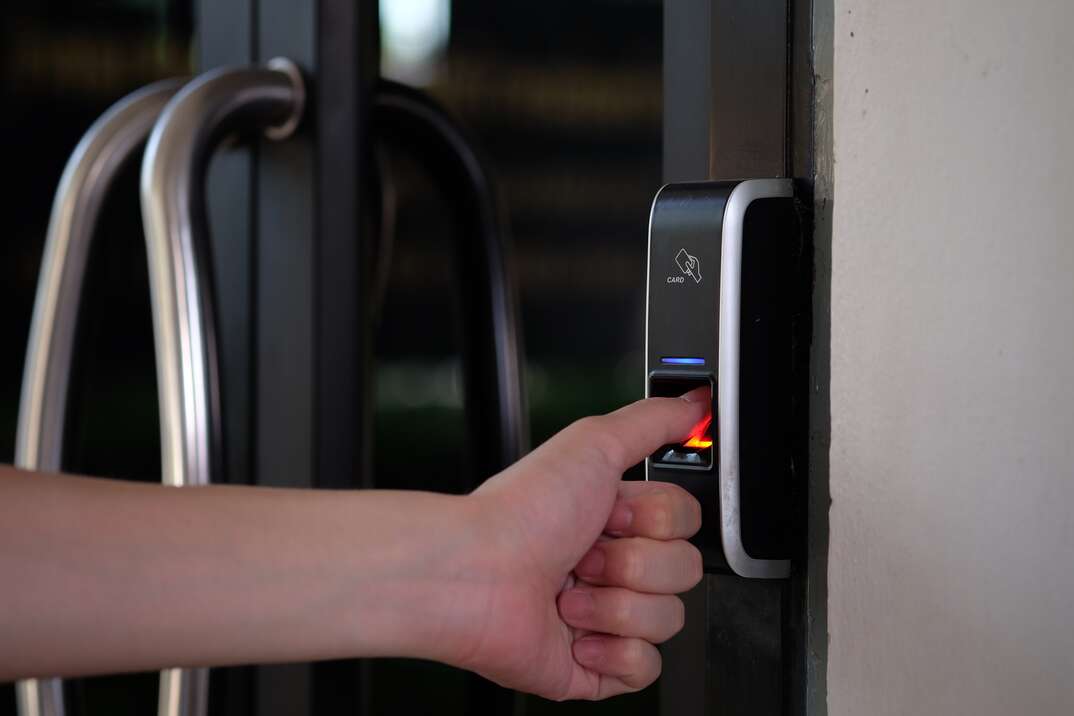- AppliancesElectriciansHVACLandscapingLocksmithPest ControlPlumbingRenovationRoofingT V RepairAll Home Improvement
- Car AccidentClass ActionCorporate LawCriminal DefenseDivorce LawEmployment LawFamily LawFinancial LawLegal AidMedical Injury LawyersMedical MalpracticeReal Estate LawWater Fire RestorationAll Legal
- InvestmentRetirementAll Finance
- Animal InsuranceAutoGeneral InsuranceHealth PolicyHome RentersAll Insurance
- DentalHealth SpecialistsAll Medical
- Animal CareVeterinaryAll Pets
- Auto GlassTowingAll Automotive
What Are Biometric Locks?

They say your home is your castle, but installing a biometric lock can help transform it into a veritable fortress — all without a key in sight.
Read More Locksmith and Security Articles
However, like most things "smart" in your home, these nifty gadgets come with a relatively hefty price tag. So, are they worth the hype, and should you consider installing one?
Biometric door locks are keyless entry systems that unlock using the homeowner's unique physical characteristics. For example, the lock may scan your fingerprint to determine your identity and unlock the door. The measurable characteristics used to unlock these systems are known as biometrics. Most systems can store the biometric information of multiple users, making them suitable for families and businesses.
Installing a biometric lock could help make your home more secure. Biometric information is exceptionally difficult to forge, so this type of lock prevents unauthorized individuals from accessing your home or business. Biometric door locks and other keyless entry systems could also be worth considering if you tend to lose or forget your keys because they let you access your home using your physical credentials.
Many homeowners find biometric locks convenient, but they're not right for every home. Issues such as noise pollution or poor lighting can prevent the biometric scanners from functioning correctly, although many models include a keypad. A keypad allows you to enter a numerical code to unlock the door, providing an alternative entry route.
Some people also worry about sharing their biometric information due to privacy concerns. Before installing a biometric door lock, it's worth checking the manufacturer's privacy policy and terms of use to determine how the company stores and uses sensitive information.
What Types of Biometric Information Can They Use to Unlock a Door?
The most common types of biometric locks are:
- Fingerprint locks
- Iris locks
- Facial scanners
- Voice recognition locks
Fingerprint door locks work similarly to smartphone fingerprint readers and are the most commonly used biometric locks. They're easy to operate, making them a good option for multigenerational families and businesses.
Iris and facial scanners contain cameras that scan the face or eye to identify the user. They don't require users to touch the lock, so they could be helpful if you're concerned about catching infections from touchpoints. However, poor lighting can make these biometric locks less reliable.
Voice recognition locks require users to say a password or phrase. They identify authorized individuals based on their speech patterns to provide contactless entry. Other sounds can interfere with the lock's ability to detect speech, making it less suitable for noisy locations.
More Related Articles:
- 8 Benefits of Installing Smart Locks
- Here’s How Much a Locksmith Charges for 5 of the Most Common Services
- Lose Your Keys Often? Here's How to Prevent Lockouts
- Installing a New Deadbolt? Here's Everything You Need to Know
- What Is Rekeying a Lock?
According to Fixr, biometric locks cost between $250 and $450 (CAD 342 and CAD 616), excluding the cost of professional installation. Although many models are suitable for DIY installation, some homeowners prefer to hire a locksmith to avoid potentially costly installation errors. Professionals typically charge between $50 and $100 (CAD 68 and CAD 137) for installation, bringing the total cost to around $300 to $550 (CAD 410 to CAD 752).
However, you could pay up to $1,200 (CAD 1,642) to purchase and install a premium brand. The most expensive biometric door locks integrate with complex home security systems for added protection against break-ins.
For comparison, HomeGuide says installing a regular front door lock costs $50 to $130 (CAD 68 to CAD 178), including materials and labor. Expect to pay between $5 and $25 (CAD 6.84 and CAD 34) for a basic manual lock without professional installation, according to data from This Old House.
All CAD conversions are based on the exchange rate on the date of publication.
Elocal Editorial Content is for educational and entertainment purposes only. Editorial Content should not be used as a substitute for advice from a licensed professional in your state reviewing your issue. Systems, equipment, issues and circumstances vary. Follow the manufacturer's safety precautions. The opinions, beliefs and viewpoints expressed by the eLocal Editorial Team and other third-party content providers do not necessarily reflect the opinions, beliefs and viewpoints of eLocal or its affiliate companies. Use of the Blog is subject to the
Website Terms and Conditions.The eLocal Editorial Team operates independently of eLocal USA's marketing and sales decisions.



